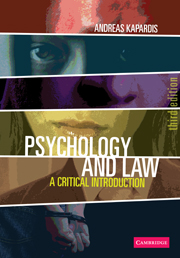Book contents
- Frontmatter
- Contents
- List of case studies
- Acknowledgements
- Foreword
- 1 Psycholegal Research: An Introduction
- 2 Eyewitnesses: Key Issues and Event Characteristics
- 3 Eyewitnesses: The Perpetrator and Interviewing
- 4 Children as Witnesses
- 5 The Jury
- 6 Sentencing as a Human Process, Victims, and Restorative Justice
- 7 The Psychologists as Expert Witnesses
- 8 Detecting Deception
- 9 Witness Recognition Procedures
- 10 Psychology and the Police
- 11 Conclusions
- Notes
- References
- Index
9 - Witness Recognition Procedures
- Frontmatter
- Contents
- List of case studies
- Acknowledgements
- Foreword
- 1 Psycholegal Research: An Introduction
- 2 Eyewitnesses: Key Issues and Event Characteristics
- 3 Eyewitnesses: The Perpetrator and Interviewing
- 4 Children as Witnesses
- 5 The Jury
- 6 Sentencing as a Human Process, Victims, and Restorative Justice
- 7 The Psychologists as Expert Witnesses
- 8 Detecting Deception
- 9 Witness Recognition Procedures
- 10 Psychology and the Police
- 11 Conclusions
- Notes
- References
- Index
Summary
Few problems can pose a greater threat to free, democratic societies than that of wrongful conviction – the conviction of an innocent person.
(Huff et al., 1986)…it has been my experience that many prosecutors prefer to have unclear, informal procedural policies for lineups so that, no matter how the lineup was conducted, it could never have violated the procedural policy.
(Wells, 2005:490)For the criminal justice system, the current findings suggest that police and courts should treat voice identification made by auditory–visual witnesses with caution.
(Bull and Clifford, 1999)All these shortcomings lead to the horrifying conclusion that in the investigation of war crimes, with hundreds of thousands of victims, identification is simultaneously the most important and the most neglected issue.
(Wagenaar, 2008:7)INTRODUCTION
Very often, the identity of the perpetrator of a crime is not an issue or it can be readily established by the prosecution. In such cases, the primary concern of police investigators is to establish the necessary points of proof regarding the charges laid against the defendant. However, in those cases where a criminal offence has been committed and the issue is whether the defendant has been identified by a witness as the person who committed it, visual witness identification may involve one of the following: single confrontation identification, photograph identification, photo-board identification, video-film identification and, finally, identification by means of a line-up (that is, an identification parade).
- Type
- Chapter
- Information
- Psychology and LawA Critical Introduction, pp. 303 - 353Publisher: Cambridge University PressPrint publication year: 2009



